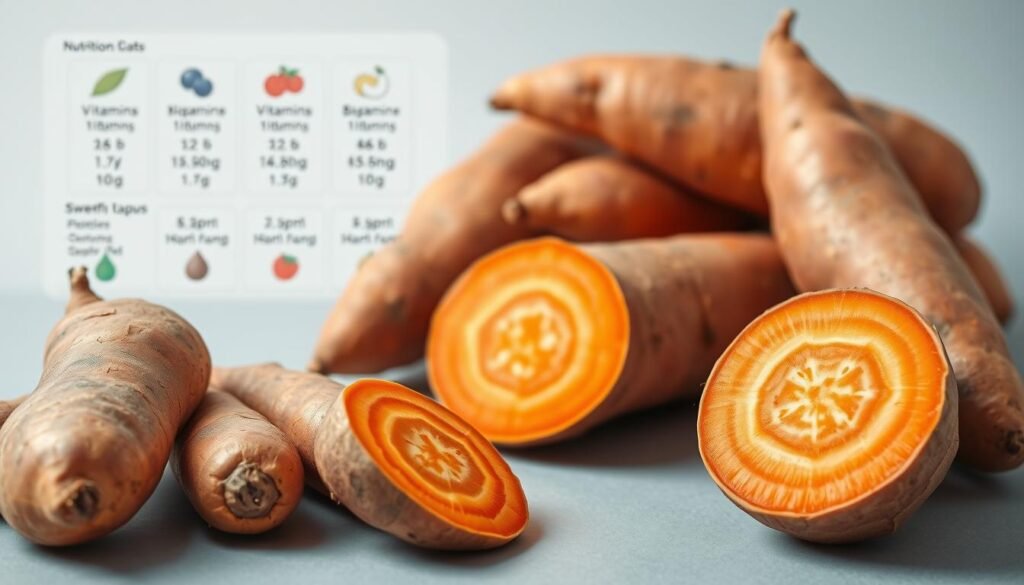Exploring the Nutritional Benefits of Traditional Japanese Sweet Potatoes

Imagine biting into a sweet and slightly nutty Japanese sweet potato. These “Satsumaimo” are more than tasty. They are packed with good stuff for your body. When I found them at a farmer’s market, their purple skin and orange flesh caught my eye. I didn’t know I’d find a new healthy favorite for my meals!
The nutritional benefits of Japanese sweet potatoes are amazing. They have lots of fiber, vitamins, and minerals. You can cook them in many ways. They make your meals tastier and healthier too.
Let’s explore the health benefits of sweet potatoes. Grown in Japan’s rich soil, they’re great for your health and happiness. They’ve gone from simple roots to stars in today’s kitchens. Sweet potatoes are truly nature’s treat for us.
Key Takeaways:
- Japanese sweet potatoes, or “Satsumaimo,” are known for their unique flavor and vibrant color.
- Rich in dietary fiber, vitamins, and minerals, they contribute to a balanced and nutritious diet.
- These sweet potatoes offer numerous health benefits, including improved immune function and digestive health.
- They can be incorporated into a variety of traditional and modern recipes.
- Discover the joys and nutritional riches of making Japanese sweet potatoes a part of your regular meals.
Introduction to Japanese Sweet Potatoes
Japanese sweet potatoes are well-loved for their unique taste and health benefits. They have purplish or reddish-brown skin with creamy insides. These are Ipomoea batatas, part of the morning glory family. They’re sweeter and firmer than other kinds.
What Are Japanese Sweet Potatoes?
Japanese sweet potatoes are great in many recipes thanks to their sweetness and texture. They offer lots of nutrients like vitamin C, potassium, and manganese. They’re full of fiber and antioxidants too. These help keep your stomach happy and fight off harmful inflammation.
A Brief History of Japanese Sweet Potatoes
Japanese sweet potatoes have an interesting story. They came to Japan in the 17th century. They helped people survive famines because they’re nutritious and grow well. They became a key part of Japan’s food and farming.
Over time, these potatoes became a favorite in Japanese cooking. Dishes range from traditional kinton to new recipes. Today, people love them for their flavor and health perks. They’re packed with beneficial nutrients.
Nutritional Profile of Japanese Sweet Potatoes
Japanese sweet potatoes pack a bunch of necessary vitamins and minerals. They make a great addition to meals, thanks to their tasty flavor and health benefits.
Key Vitamins and Minerals
A medium Japanese sweet potato has lots of key nutrients like vitamin A, C, E, and B6. These help keep your eyes sharp, immunity strong, and skin glowing. Plus, they’re full of potassium for blood pressure and manganese for bones and metabolism.
Dietary Fiber Content
These sweet potatoes are also rich in fiber. This means they aid digestion and keep your gut healthy. The fibers keep you regular and lower digestion issues. So, eating them is good for both taste and digestive health.

Antioxidants in Sweet Potatoes
They’re full of antioxidants like vitamins C and E too. These antioxidants fight oxidative stress and protect cells. Eating foods rich in antioxidants, like these potatoes, helps prevent diseases and keeps you healthy.
Health Benefits of Japanese Sweet Potatoes
Did you know Japanese sweet potatoes are great for your health? They’re tasty and full of good stuff for your body and mind!

Boosting Immune Function
These sweet potatoes have lots of vitamins C and E. They help your immune system. They are good at fighting off sickness. They do this by attacking harmful stuff in your body. Eating these has helped me stay healthy, even when others get sick.
Supporting Digestive Health
Want better digestion? You’re in luck! Japanese sweet potatoes have lots of fiber. This helps keep your digestion regular. It’s a natural way to avoid constipation. Why not help your gut by eating these yummy sweet potatoes?
Promoting Healthy Skin
Everyone wants great skin. Japanese sweet potatoes can help. They have antioxidants that keep your skin looking young. My skin is brighter and healthier after eating these. The antioxidants also protect your skin from daily harm.
Japanese sweet potatoes are not just good to eat. They’re key for a healthy diet. So, let’s start cooking and enjoy these health benefits together!
Japanese Sweet Potatoes vs. Regular Sweet Potatoes
Diving into the sweet potato world shows key differences between Japanese and regular kinds. Japanese sweet potatoes are packed with special nutrients. They have a unique taste that makes them different from other sweet potatoes.
Nutritional Comparison
Japanese sweet potatoes have lots of vitamins C and E. These are great for your immune system and skin. But, regular sweet potatoes have more vitamin A. This is good for your eyes and immune system.
| Nutrient | Japanese Sweet Potatoes | Regular Sweet Potatoes |
|---|---|---|
| Vitamin C | High | Medium |
| Vitamin E | High | Low |
| Vitamin A | Low | High |
| Fiber | Moderate | High |

Taste and Texture Differences
Japanese sweet potatoes are firmer and sweeter. They taste a bit like chestnuts. If you like a rich taste, you might prefer them. Regular sweet potatoes are softer and sweeter. They’re great for pies and casseroles.
In short, knowing the differences between sweet potato types can help you pick the best one for cooking. Whether you like Japanese sweet potatoes or regular ones, each brings its own special taste and benefits.
Versatility in Cooking and Preparation
Japanese sweet potatoes are a delight in the kitchen! They are super versatile and taste great. You can make lots of dishes from them, like tempura and roasted wedges. Plus, they are full of health benefits because they have lots of nutrients and antioxidants.

Traditional Japanese Dishes Featuring Sweet Potatoes
In traditional Japanese food, sweet potatoes are used in many ways. They shine in dishes, showing off their sweetness and texture. A favorite is daigaku imo, where they’re fried and then coated in a sweet soy glaze. There’s also sweet potato tempura, which is crispy and golden.
Sweet potatoes also show up in osechi ryori during New Year’s. They’re cooked with chestnuts for a special treat.
Modern Recipes to Try
Looking for something new? Try modern recipes! You can make roasted sweet potato wedges. Just cut them into wedges, add some olive oil, and roast. They get sweet and crispy, which is perfect as a side dish or a snack.
Or make mashed sweet potatoes. Add a bit of maple syrup and cinnamon for flavor. This dish is tasty and healthy. It’s good for digestion and has vitamins.
You can try traditional recipes or something new. Sweet potatoes come with lots of health benefits. They make food tasty and good for you. So have fun cooking and trying different ways to enjoy Japanese sweet potatoes!
Incorporating Japanese Sweet Potatoes into a Balanced Diet
Adding Japanese sweet potatoes to your meals can boost your nutrition. These yummy tubers are full of important nutrients. They help keep your calories low! Want to know how to include them in your diet? Here are some tips!

Recommended Serving Sizes
Starting with portion size is important. Aim for half a medium-sized Japanese sweet potato per meal. This amount allows you to enjoy the benefits without too many carbs. You’ll get lots of Vitamin A, fiber, and antioxidants.
Pairing with Other Nutrient-Dense Foods
For a complete meal, add Japanese sweet potatoes to superfoods. Try them with grilled chicken or tofu, a leafy green salad, and quinoa. This combo is a nutritional powerhouse. It adds delicious flavors and gives you proteins, complex carbs, and vital vitamins.
Ready to try it? Sweet potatoes are super flexible in meals. They are a great boost to a balanced diet. Let’s indulge in these tasty tubers and their amazing nutrition!
Potential Drawbacks and Considerations
Japanese sweet potatoes are full of good nutrition. But, we must think about some possible downsides. Let’s look into what to watch out for!
Allergies and Sensitivities
Some people might be allergic or sensitive to sweet potatoes, though it’s not common. They could feel mild itching or face swelling up to worse cases. If you think you’re allergic, it’s best to talk to a doctor. Knowing how sweet potatoes affect you helps balance their health perks with your food choices.

Glycemic Index and Diabetes
It’s also important to consider the glycemic index (GI) of Japanese sweet potatoes. They have a moderate GI, meaning they can influence your blood sugar. This is especially vital for those managing diabetes. To enjoy these potatoes without a sugar spike, mix them with high-fiber foods. This way, you can benefit from sweet potatoes without messing with your diet.
Cultural Significance of Japanese Sweet Potatoes
Japanese sweet potatoes are very important in Japan’s culture and food. They have a long history and taste great, making them more than just healthy food. They are part of traditions and celebrations that many generations have enjoyed. The impact of sweet potatoes is seen in many parts of Japanese society, like festivals and food symbolism.

Festivals and Celebrations
One big way we see Japanese sweet potato traditions is during fall harvest festivals. These festivals celebrate the year’s crops, with sweet potatoes playing a big role. They stand for wealth and health, which is why they’re eaten a lot during these times. Families love to eat roasted sweet potatoes. This makes the streets and homes smell amazing. Sweet potatoes are also important in Obon and New Year celebrations, showing their key role in Japanese festivals.
Symbolism in Japanese Cuisine
In Japanese food, sweet potatoes are not just for cooking; they mean a lot more. They symbolize long life and being strong, which are valued in Japanese culture. Foods like daigaku imo and satsumaimo tempura are not just tasty. They also connect people to important traditions. Sweet potatoes are even given to gods in Shinto rituals as a way to show thanks and respect. This shows how much Japanese sweet potato traditions are part of life in Japan.
| Festival | Celebration Activity |
|---|---|
| Fall Harvest Festival | Roasting and enjoying sweet potatoes as a symbol of prosperity and good health. |
| Obon | Offering sweet potatoes to ancestors as part of the traditional celebration. |
| New Year Festivities | Incorporating sweet potatoes into celebratory dishes to bring good fortune for the year ahead. |
Sustainability and Locally Grown Options
Hey there! Are you excited to learn about local Japanese sweet potatoes? I sure am! Choosing these tasty tubers helps the planet and your community.

Benefits of Consuming Local Produce
Local Japanese sweet potatoes help reduce our carbon footprint. This happens by lowering the distance food travels to us. Less travel means less fuel used and fewer emissions.
Also, buying local supports our community’s economy. It puts money into the hands of local farmers. This helps build a strong community where everyone supports each other.
Impact on Community Agriculture
When we choose locally grown produce like sweet potatoes, our community agriculture grows. This demand helps farmers grow more and create more jobs. It strengthens our local food systems too.
This support is very important for small farms. It gives them the stability to keep making healthy food for us.
To make things clear, here are the benefits:
| Benefit | Description |
|---|---|
| Reduced Emissions | Shorter transport routes mean less fuel consumption and lower carbon emissions. |
| Economic Boost | Money spent on local produce supports local farmers and strengthens the local economy. |
| Job Creation | More demand for local crops leads to increased farming activities and job opportunities. |
| Improved Food Security | Supporting local agriculture ensures a steady supply of fresh, nutritious food. |
Choosing local Japanese sweet potatoes does a lot of good. Let’s make our next meal sustainable!
Storing and Handling Japanese Sweet Potatoes
Knowing the right way to store sweet potatoes keeps them fresh. This way, they stay tasty and full of good stuff. By cooking them well, their flavors shine!

Best Practices for Longevity
Keep sweet potatoes in a cool, dry place. Don’t put them in the fridge. The cold ruins their texture and taste.
Store them where air can move around them. This could be in your pantry or a dark spot in the kitchen. Good airflow stops mold and keeps them fresh longer.
Tips for Preparation and Cooking
First, wash the sweet potatoes well to remove dirt. To make them soft and tasty, roast them at 400°F. This takes about 45-60 minutes.
Cutting them into rounds makes them cook faster. Steaming is another great way. It keeps their sweetness and moistness.
These tips make cooking Japanese sweet potatoes easy. Your meals will be healthy and yummy. Get ready for some delicious eating!
Conclusion: Embracing Japanese Sweet Potatoes
After exploring Japanese sweet potatoes, we see their amazing benefits. They are full of vitamins like A and C. They also have a lot of fiber and antioxidants. These make them a great choice for healthy eating. They have a low glycemic index too. This means they are good for keeping blood sugar steady.
Summary of Nutritional Benefits
Japanese sweet potatoes help with immune function and digestion. They also make our skin look healthy. They are a great choice for anyone wanting foods rich in nutrients. Compared to regular sweet potatoes, the Japanese ones taste different. They also feel different, making your meals more exciting.
Encouragement to Experiment with Recipes
Feeling excited? Now’s the time to try cooking with Japanese sweet potatoes. You can roast them or use them in traditional dishes. Or you could try something new. There are so many recipes to explore. By adding them to your diet, you’ll make meals more fun and healthy. Let’s start cooking and explore new flavors!